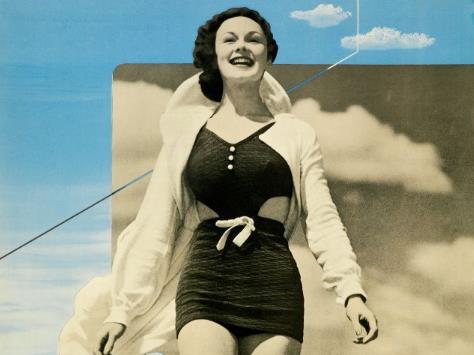Brave New World: Australia 1930s at The Ian Potter Centre: NGV Australia.
On the third floor of the Ian Potter Gallery, NGV, a Brave New World: Australia 1930s beacons. One driven by technological advancement and the age of the machine. A world excited about ‘progress’ and its imagined panacea for a better life and yet driven by economic turmoil and political unrest. Like Aldous Huxley’s classic 1932 novel of the same name the Brave New World exhibition explores the powerful impact these utopian ideals and dystopian realities had on the arts of 1930s Australia.
Before reflecting on the work, the thoughtful design of the gallery space is worth consideration. A labyrinth of passages broadening to intimate viewing areas allow the themes of utopian cities, modernism, the modern woman, national identity, indigenous art and dystopian cities to emerge. The heightened lighting effects or variously coloured and imaged walls act as a back drop to a wide range of art forms from painting, film and fashion to furniture and architecture, providing the visitor with a multi-dimensional view of this turbulent era between two world wars and the Great Depression.
Grace Cossington Smith’s The Bridge in-curve,(1930), tempera on cardboard, symbolises the notion of progress. One of many images of the bridge’s construction, the painting depicts the looming arches of the harbour bridge just prior to completion. Close by furniture designed by Fred Ward such as Tray table,(1932), from mountain ash, blackwood and steel, reflects the changing nature of design and the influence of modernist principles. But it is the miniature metropolis of Bakelite clad radios,( an early form of plastic), further along the labyrinth, that highlights the successful mass production of technology and good design for the domestic setting.
In her painting The babe is wise, (1940) oil on cardboard, Lina Bryans captures a sense of the modern women. The sitter looks out from the picture plane directly at the viewer; her hat cocked slightly as though to challenge preconceptions of femininity. Like the silk Evening dress, (1935) on displayed close by, ones gaze is drawn from the face to a plunging neckline while the impressionistic brush strokes reflect the vitality of the modern woman. From the vantage point of 21st century eyes, the black and white film advertisement for cinema, It isn’t Done, (1930), promoting the freedom of the new undergarment appears quaint but it too reflects an important step towards greater female emancipation.
As the labyrinth winds on the viewer is required to reflect on the role of the artist in a young nation’s search for identity. The ‘body’ image had now become a symbol of a life-style; one of health and endless opportunity from the beach to bush. Works such as Daphne Mayo’s bronze and marble bust, A Young Australian, (1930) and Max Dupain’s iconic gelatine and silver photograph Sunbaker, (1938, printed c.1975) reflect this growing sense of national character. In the collaborative advertising photomontage Australia, (c.1937), by Douglas Annand and Max Dupain, a young woman features. Clad in her bathing suit and smiling broadly she runs towards the viewer, the sky meeting the sea in the background. A land of endless sun, sand and opportunity.
The visual arts not only help define an era but can act as social commentator. They reflect the 1930s as a time of inconsistencies; the White Australia Policy and assimilation rubbing shoulders with the growing interest in indigenous art. Albert Namatjira’s work Central Mount Wedge from MacDonnell Ranges, (1937), is an example of his hugely popular, western styled water colour paintings. Traditional indigenous iconography however was also emerging as an important influence in the works of non-indigenous artists such as Margaret Preston and Frances Derham who incorporated traditional design elements in their art-making with the aim of producing something uniquely Australian.
By exhibition end, utopian and dystopian collide through the social realist images of Danila Vassilief and Yosl Bergner. The poor and dispossessed hit hard by the Great Depression and rapid change became the focus of their image making. Art had now become a political tool. In City Lane, (1940), oil on composition board and Metho drinker, (1938), pencil over brown ink wash, Bergner reflects the harsh reality of urbanised life. Danila Vassilieff’s Street scene with graffiti, oil on plywood, (1938) however is suggestive of urban change as the decade draws to a close. While horse and buggy move out of the picture frame to the right, the viewer’s eye is drawn to the boy and dog standing before a heavily graffitied background, symbolising perhaps the cusp of a new era. The move from one world to another.
An ambitious and finely curated exhibition which includes interpretive panels, kids text and display boxes to provide greater contextual understanding for some art works.
Rating: 4 stars out of 5
Brave New World: Australia 1930s
NGV Australia, Federation Square
14 July – 15 October 2017
Open 10am-5pm daily – entry fees apply





